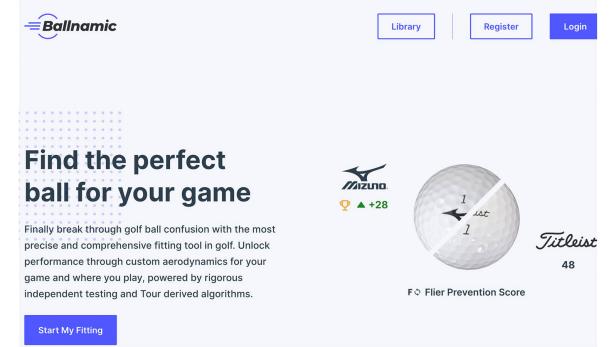Ping’s latest fitting technology focuses exclusively on a product the company doesn’t make—balls | Golf Equipment: Clubs, Balls, Bags
WHAT YOU NEED TO KNOW: Using proprietary ball-flight models, predictive algorithms and company research of dozens of premium golf ball brands, Ping is introducing Ballnamic, a web-based, ball-fitting tool that uses player swing data and performance preferences to match a specific ball for each golfer.
PRICE: $39 (available at ballfitting.com).
THE DEEP DIVE: What does a major equipment company that’s not in the ball business know about golf balls? Turns out a lot, especially if that company has long been regarded as the leader in fitting golfers to the right equipment. Using its proprietary knowledge, based on its own ball-flight simulation algorithms, robot testing and research on dozens of different golf ball brands and models, Ping has developed a web-based golf ball fitting tool that golfers can use to find their perfect match. The cost for the experience, known as Ballnamic, is less than the price of a dozen premium balls.
Here’s how it works: Golfers answer a series of questions about their games, swing characteristics and launch conditions, and the website recommends a series of balls, each with a specific score on a 100-point scale to determine the best match for each player. It’s a kind of eHarmony meets Ping Man.
What Ping’s research mainly has discovered is that ball fitting, while more complex, is in some ways potentially just as beneficial as club fitting, especially when the two are combined. Ping’s study also suggests the way a ball performs for an individual swing is beyond the typical designations like “low spin” or “high launch.”
“One of the most exciting advancements is that we decouple and approximate a ball’s initial launch conditions with its aerodynamic performance,” said Marty Jertson, Ping’s vice president of fitting and performance. “It’s counterintuitive, but we’ve seen low-launch, low-spin golf balls that fly high, and high-launch, high-spin balls that fly low. It does not factor in traditional ball-selection criteria, such as construction and number of layers. Instead, Ballnamic strictly focuses on tested performance characteristics, algorithmic equations and mathematical approximations.”
After a golfer inputs swing information, launch conditions or yardages with the driver and 7-iron and playing preferences (trajectory, feel, short-game spin preference, etc.), a report contrasts the top five best-matched balls on a 100-point scale. The Ballnamic fitting database currently includes 45 multilayer urethaneballs from Bridgestone, Callaway, Cut, Kirkland, Maxfli, Mizuno, OnCore, Snell, Srixon, TaylorMade, Titleist, Vice, Volvik, Wilson and XXIO. Jertson indicated the list of balls under consideration is being updated regularly and non-urethane cover balls may be added at some point. "Our goal is to characterize and best match balls to golfers regardless of construction," he said.
In making the selections, the Ballnamic algorithm determines its customized choices based on various playability preferences, in addition to the data on distances. For example, if a player decides that under the 7-iron, he or she only wants “some workability,” that aspect of a ball’s performance is weighted half as much as if he or she had chosen “most workability.” Those answers lead down a path to different ball recommendations, and sometimes clubs, Jertson said.
“It’s been eye-opening to see the impact that different balls have on dialing in someone’s fitting recommendations,” Jertson said. “While Ballnamic provides useful information as a stand-alone tool, we’ve also seen the benefits of combining club and ball fitting. For example, we’ve seen optimization benefits in players achieving greater distance while using a higher-lofted driver with better-matched golf balls.”
What Ballnamic certainly does is provide a first step in the selection process that spurs more thought. It’s not unusual for an individual’s top three or four balls to be separated by only a percentage point or two. While one ball may win overall, Ballnamic breaks down the choices across 10 criteria, including distance with the driver and 7-iron, as well as 7-iron workability, full-wedge spin and driver wind score. (The latter is a Ping calculation of driver carry distance into the wind.) Again, those differences may be slight, and a player may only find one of the five recommended balls that matches his or her preferred feel, for example.
“I think what we’re on to is the power of modeling,” Jertson said of the algorithms being developed by the company for club and ball fitting. “We can make predictions and those predictions can actually be better than the player actually hitting lots and lots of shots trying to test it.”
Players can sign up for the Ballnamic fitting at the website ballfitting.com. The cost is $39.








Gloss